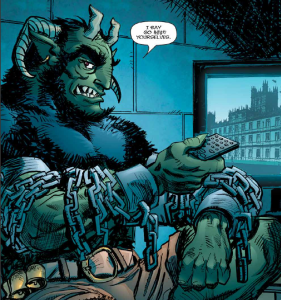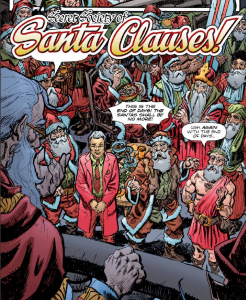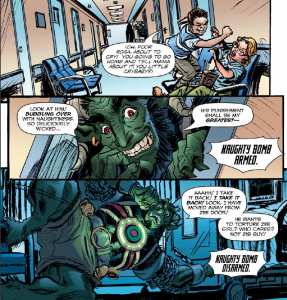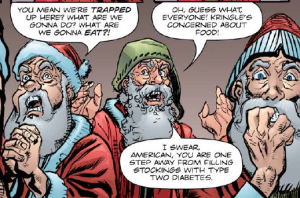Last year I read Krampus as it was released as single issues, but didn’t get around to writing about it. Recently I was thinking about Krampus as we moved into the holiday season and it seems to coincide with Image releasing the book as a trade collection on 3 December at your local comic shop or 16 December everywhere else.

We have a lot of traditions that come from long ago – so long ago that they seem a bit odd today. A lot of this is due to a change in our sensibilities. In my daughter’s Little Red Riding Hood, no one is eaten. The wolf just gets grandma out of the way for a while. In the old Cinderella, the stepsisters are mutilating their feet to get them into the slippers. And in many European traditions Santa used to go around with a helper to punish the bad kids. One of those was Krampus, a demon. Wikipedia claims this still goes on in some countries. In the story as told by this comic, Krampus has been jailed for being a little too over-enthusiastic in his punishment of the bad kids.
Of course, the whole idea of Christmas being about an omniscient, overgrown, present-distributing elf is somewhat odd in its own right. I can certainly understand the thought process of the parents who came up with the “he knows if you’ve been bad or good” idea. And I know all the cliche jokes we make about that omniscience as adults, but I can tell you with certainty that, like employees at evaluation time, the only time Santa governed my behavior was around Christmas. The rest of the year it was either fear of Jesus/God or (more often) fear of parental punishment that kept me in line. The only movie I’ve seen tackle that is the Disney Christmas Part 2 segment in which Huey, Duey, and Louie realize they’ve been bad all year and aren’t getting presents. Even when I did think about it, the worst possibility was getting coal instead of toys. Although I seem to remember some of the adults around me saying he also left reindeer poop for bad kids.

Brian Joines, the writer of Krampus, has a bit of fun with the whole thing. The first issue has him writing that Sinterkaas, the first Santa, found himself overwhelmed by the number of children needing gifts. So he decided to stop giving gifts to bad kids and to use dark magick to bring forth Krampus. Later after Krampus decides not to listen to the decision not to punish kids, he’s captured and imprisoned. That would be a pretty fun setup on its own, but Joines also creates the Secret Society of Santa Clauses.
In a move similar to what Neil Gaiman does with American Gods, Joines has each culture’s idea of Santa personified. So at the North Pole we see about 2-3 dozen Santas of every race, culture, and ethnicity. Additionally, this society has grown to become the most inefficient bureaucracy imaginable, at least when it comes to Santa governance.

Into this rich tapestry a murder mystery story is woven. One of the many Santas is murdered and eventually they decide to send the Krampus out to investigate. They do put a naughty-detecting bomb on him to keep him from going rogue, so they aren’t completely clueless. The plot seems to be straight genre murder mystery with lots of the usual tropes, but lots of fun jokes related to a world filled with Santas and other Christmas characters. To give you an idea of the type of humor in this story – Doc Holiday is involved in this story of holiday characters simply because of his last name and a mixup in heaven or some other such divine place.

Part of the fun of revisiting these characters from our youths is a mix of being able to poke fun at the silly things we believe as kids, but also being able to do deconstructions on concepts based on the cynicism of adulthood. As children we’re willing to accept the idea of an old man and a bunch of elves living at the north pole making our toys. But Futurama shows us that in real life it’d probably be a sweat shop. It also deals with the naughty and nice issues I discussed early on. Krampus takes what would be an innocent concept in a kid’s movie – a society of Santas – and makes it more realistic. They bicker and jockey for power. Some of them are real jerks and others are pushovers. As Harry Potter is to the magical applied to school Krampus is the magical applied to corporate structure. Way too often it seemed to overlap with a sense that I’d seen these characters at work, even if they weren’t all dressed in red.
Joines takes a plot that seems like it couldn’t work and makes it work by virtue of not taking himself too seriously. Krampus is a great character because he is such a stereotypical anti-hero. It’s a fun read and almost guaranteed to be different from anything else you’ll be reading in comics this winter.
Krampus Written by Brian Joines with art by Dean Kotz, colors by Ron Riley, and letters by Charles Pritchett.
